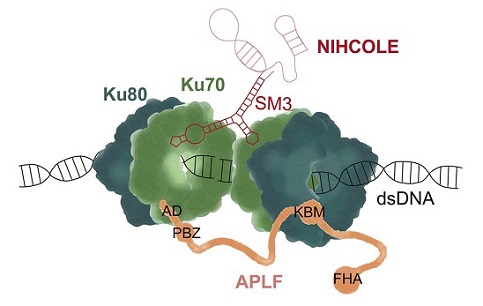Cancer News: Scientists Identify A ‘Molecular Staple’ Called NIHCOLE That Impedes Liver Cancer Treatment
Cancer News - NIHCOLE Mar 07, 2023 2 years, 9 months, 3 weeks, 3 days, 8 hours, 55 minutes ago
Cancer News: A new study published in Cell Reports by researchers from the Spanish National Cancer Research Centre (CNIO), the Spanish National Centre for Biotechnology (CNB), and the Centre for Applied Medical Research at the University of Navarra (CIMA-University of Navarra) has identified a novel DNA repair system that impedes liver cancer treatment. The study sheds light on the function of a molecular staple, which helps repair broken DNA in liver cancer cells, making them resistant to radiotherapy and chemotherapy.
 The Role of DNA Repair in Cancer Treatment
The Role of DNA Repair in Cancer Treatment
Error correction is crucial for cells due to the constant occurrence of malfunctions during cellular activity. However, inducing errors is beneficial in the effort to kill cancer cells. Radiotherapy and chemotherapy induce cellular defects by damaging the DNA of cancer cells. Unfortunately, some tumor cells possess a highly effective DNA repair system, enabling them to escape treatment. Patients with liver cancer reporting failure with current conventional treatment protocols is growing problem as reported by various
Cancer News coverages.
Researchers have been studying these DNA repair systems in hopes of developing strategies to combat cancers with the worst prognosis. A few years ago, a team led by Dr Puri Fortes from CIMA-University of Navarra discovered that about half of patients with hepatocellular carcinoma, the most common type of liver cancer, produce an RNA molecule called NIHCOLE. NIHCOLE is found mainly in the most aggressive tumors and is associated with a poor prognosis. Dr Fortes, Dr Óscar Llorca from CNIO, and Dr Fernando Moreno-Herrero from CNB concluded that NIHCOLE is very effective at helping repair broken DNA, which is why radiotherapy is less effective in tumors where it is present. By eliminating NIHCOLE, cancer cells treated with radiotherapy die more easily.
The Function of the Molecular Staple
The molecular mechanism by which NIHCOLE facilitates the repair of DNA breaks was not known until now. The study shows that NIHCOLE forms a bridge that binds the broken DNA fragments together, acting as a molecular staple. “NIHCOLE interacts simultaneously with proteins that recognize the two ends of a fragmented DNA, as if stapling them together,” explain Dr Llorca and Dr Moreno-Herrero.
It is also surprising that only a small piece of NIHCOLE is required for it to act as a molecular staple.
Understanding this mechanism may help in the development of strategies to combat liver cancers with the worst prognosis.
This would allow the development of drugs that block or distort this structure, and thus improve the efficacy of radiotherapy or chemotherapy in cancer patients,” say the authors of the paper.
The study team suggest that the use of NIHCOLE inhibitor drugs may represent a new therapy for the most common form of liver cancer. This would allow the development of drugs that block or distort the structure of NIHCOLE, improving the efficacy of radiotherapy or chemotherapy in cancer patients.
Nanotechnology Method for Studying NIHCOLE
In order to understand how NIHCOLE work
s, Dr Fernando Moreno-Herrero’s group from CNB used magnetic tweezers, a nanotechnology technique that allows the physical properties of individual molecules to be studied. Researchers have designed a DNA molecule that mimics broken DNA, allowing them to detect the junction between the two fragmented ends. First, they attach a tiny magnetic bead, on the scale of a thousandth of a millimeter, to one end of the DNA, and then use magnetic nano-tweezers to pull on that end. The length of the stretched DNA indicates whether it is a reconstituted DNA molecule, in which the broken ends of the DNA have been joined together, or whether it is still broken.
These data show that NIHCOLE “confers advantages on tumor cells by helping them to repair DNA breaks, thereby sustaining the malignant proliferation of cancer cells despite the accumulation of DNA damage resulting from the stress of cell division itself,” say the authors of the study.
Junk DNA No More
NIHCOLE is not a protein synthesized by a gene, but an RNA molecule. It is part of what biologists dubbed junk DNA two decades ago when the human genome was being sequenced. At the time, biologists mistakenly believed that this DNA was useless.
Dr Llorca explains: “One of the central dogmas of biology is that the information contained in each gene, in DNA, is translated into proteins. So scientists were stunned when they discovered that only 2% of our DNA contained genes; what was the rest of our genome for? It is unthinkable that 98% of the genome is junk, useless DNA. In the last decade, it has been shown that part of this dark genome produces very long RNA molecules, some of which have a prevalent function in cancer.”
The study findings were published in the peer reviewed journal: Cell Reports.
https://www.sciencedirect.com/science/article/pii/S2211124722018162
For the latest
Cancer News, keep on logging to Thailand Medical News.
